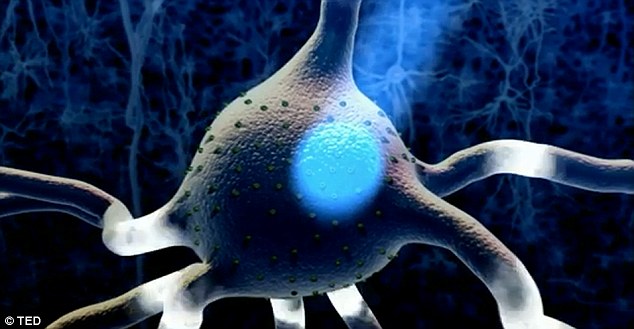PUBLISHED:18:49 EST, 26 October 2012| UPDATED:18:49 EST, 26 October 2012
A scientist at MIT could be on track to uncovering how to restore lost memories in the brain.
Using light stimulation to control neurons and map out brain activity, scientists could repair neuron functionality in cases where a stroke, Alzheimer’s and other degenerative diseases have caused reduced brain functionality.
Dr Ed Boyden, a researcher at the Massachusetts university, is studying how to code brain pathways and eventually could discover how to code memories and re-upload that information to restore neuron functionality.
Scroll down for video.

Brain science: There are approximately 100 billion neurons in the human brain, which scientists are attempting to map and control (stock image)

Ray of light: A protein, channelrhodopsin (ChR) which is actually extracted from algae, can be inserted into neurons to convert light into electricity
The human brain has approximately 100 billion neurons that pass along information.
Dr Boyden, who leads the Synthetic Neurobiology Group at the MIT Media Lab, is studying how to use light to control neuron activity and to decode brain patterns.
He has identified a protein, channelrhodopsin (ChR) which is actually extracted from algae, that can convert light into electricity.

Dr Ed Boyden leads the Synthetic Neurobiology Group at the MIT Media Lab
When this protein is inserted into neurons it prompts neurons to respond to flashing lights and send an electrical signal.
With this inserted protein in place, Boyden and his team could begin mapping out electrical signals sent in the brain triggered by light, using a specially designed computer program.
The impact of light could become an ‘on-off’ switch for neuron activity.
Additionally, the light sensitive protein could allow the brain to be translated into a binary code that allows for the mapping of these complex pathways.
If brain pathways could be coded, it would allow for that information to be converted and stored.
Memories could be coded and that code saved, available to be re-introduced should neuron functionality diminish over time.
Testing in mice has proved successful in treating brain disorders and as the experiments continue, it could greatly impact treatments for debilitating brain degeneration
Read more: http://www.dailymail.co.uk/news/article-2223834/Are-downloadable-memories-just-round-corner.html#ixzz2ATYlPzZH Follow us: @MailOnline on Twitter | DailyMail on Facebook